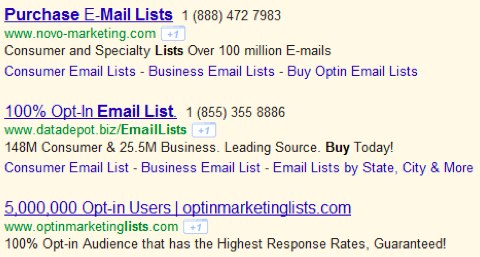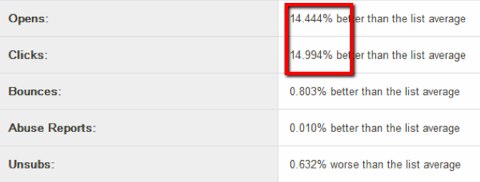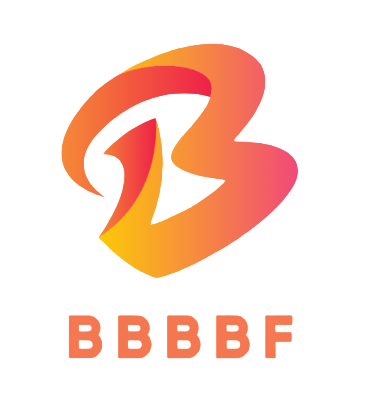Email newsletters are one of the greatest ways to monetize your social media efforts. But it’s really easy to make mistakes too.
Would you like to know how to build a great email newsletter list without making the common mistakes that can ruin your reputation and cost you money? If so, read on to learn how to avoid these 5 mistakes.
Mistake #1: Buying lists
Most email marketers who’ve been around for awhile know that buying a list is a bad idea. Still, lists are for sale, and the temptation is there. For example, here are the sponsored searches for “buy email list” on Google:

To those of you who are new to email marketing, you have to understand that buying a list can harm your business. Here are a few things that can happen to you. You can be:
- Blacklisted by your Internet Service Provider.
- Fired by your email service provider.
- Viewed as a spammer by those who you email on that list.
So what’s the best way to grow a list organically?
- Sidebar Opt-in Box – This option is by far the most popular and most basic. It’s what I use, and it’s proven very successful to grow my email list. You can easily create one through AWeber and actually have an option where if someone is logged into Facebook, they can subscribe with one click (this converts at 51.6% better than if you didn’t use the Facebook option).
- Hello Bar – Another way to promote your email newsletter subscription is to use the Hello Bar. Bloggers like Darren Rowse and Tim Ferriss use it on their sites to promote products, but you can just as easily use it to promote your email newsletter.
- Free Product – One of the best ways in my experience to generate sign-ups for an email newsletter is through the promotion of a free product. It could be a white paper, ebook or an app. Just ask for an email address in exchange for the product. Make it clear that the subscriber is also getting the newsletter.
- Lightbox – A lightbox is just a simple pop-up that lays over your website when a visitor arrives. An “x” in the top right corner makes it easy for users to close it, but it typically boosts your conversion rate.
- End of Post Subscribe Box – Sticking a subscription box at the end of each of your posts is also an effective way to boost sub-conversions.
- Landing Pages – Finally, I’ve seen some content marketers devote entire landing pages to their email newsletter subscription.
Mistake #2: Focusing on quantity and not quality
If you are chasing quantity over quality when it comes to your email newsletter list, then you are wasting your time.
A large list isn’t necessarily a good thing. That large list is difficult to manage and probably represents a large number of people who were only slightly interested in signing up.
One email marketer I know shaved off almost 90 percent of his list after cleaning it up…but doubled his conversions! How does a smaller list improve conversion? It’s all about engagement. It’s interesting, but when it comes to ISPs, they look at engagement when deciding whether to put your emails through. ISPs can see your metrics, so if you have a large list that’s pretty much dead, then they’ll suspect it’s a spam list.
Here’s how to keep your list active, no matter the size:
- Run a re-engagement campaign – Copyblogger is really good about this. About every two years, they will send out an email asking if you want to continue to receive their emails. This helps keep readers connected, engaged and interested.
- Offer frequency options – If you send out emails daily or even multiple times a day like Writer’s Digest does, I’d recommend offering a sign up for a summary email at the end of the week.
- Segment your list – If you really want to improve conversions, break your list into segments depending on demographics like age, income, jobs or gender. Creating content targeted to these groups will work wonders for your conversion.
If you still doubt that you need to segment your list, check out Mail Chimp’s segmentation numbers. They measured multiple industries and found that email marketers got nearly 15% better open and click rates when they segmented.

With so much information flooding people these days, quality is so much more important than quantity, so make sure you engage with quality content, offer frequency options and segment your list.
Mistake #3: Not setting expectations on content, frequency and design
One of the first emails that you should send out is a short introductory email. This email should set expectations about what kind of content you are going to send your subscribers and how often. Of course, your subscribers should know this information before they subscribe.
Here are a few guidelines when it comes to setting expectations:
- Content – When it comes to what you put in your email newsletter, you need to outline everything that will be in there, from tips and ideas to discounts and sales.
- Frequency – Make sure your potential subscriber knows how many email newsletters to expect from you. I’ve seen a lot of email marketers who are sporadic about how often they send out content. If too much time passes between emails, your readers may lose interest or simply forget why they signed up in the first place.
- Design – It’s not a bad practice to give people an idea of what your email design is going to look like. Then, it’s important to maintain that design throughout the life of the email newsletter. If you do decide to change the look of the email, make sure you get the input of your readers, base your redesign on your tests and then explain to your readers what to expect and when.
Here are some scary stats that will make you pay attention to the best practices:
- Percent of people reporting email as spam even though they know it isn’t: 21%!
- Number of people who click on the spam button based on the “From” field: 2.43%.
- People who report email as spam based upon subject line: 3.69%.
You’ve got to set expectations, but you also have to meet them. Make promises and don’t break them, or your subscribers will never forgive you!
Mistake #4: Only looking at open rates
A lot of content marketers pay close attention to open rates. While that’s important, it’s better to keep your eye on total clicks. Unfortunately, an open is not always registered, since some metrics are dependant upon whether the images are displayed. So, what other metrics should you measure?
- Clicks
- Soft Bounces
- Hard Bounces
- Abuse Complaints
- Unsubscribes
Use Mail Chimps email marketing benchmarks to help you set achievable goals.

These days, most email accounts like Gmail have the images turned off by default. So your subscriber could open the email and click around, but the stats won’t show up in your numbers.
Furthermore, about 84% of people use the “preview pane” to view email. That’s not rendered as an open.
While it’s definitely not a bad idea to have a goal to raise your open rate from 2% to 10%, make sure you don’t neglect the click ratio. Don’t forget to test different ways to encourage people to share your content.
Mistake #5: Writing content that is boring or re-purposed
Your relationship with your reader is the most important part of your email newsletter. You need their permission to market to them, which is the first step to building a great relationship. Now you need to send them useful content that tells them you care about them.
But that’s not enough. The content has to be unique and useful. Bad email newsletter marketers will simply send rehashed blog posts, which is a bad idea. One selling point to entice subscribers to keep subscribed is to show that your email newsletter is a place where you share special reports, information and findings.
For example, here are some good ways to think of the content you provide in your email newsletters:
- Cornerstone content – This is the content that will make up most of what you give your readers. It’s what defines you. If you’re an SEO, then you’ll write about SEO. If you’re a graphic designer, you’ll give content based on graphic design.
- Personal content – Don’t forget to share personal stories. Most of your readers will be around to learn what you have to say about your area of expertise, but sharing personal stories will build a great relationship with them.
- Spicy content – Finally, you should also occasionally write spicy posts. Write about a high-profile figure that you disagree with or about something controversial. These email pieces are going to be the ones that probably will get forwarded the most.

Comments (0)